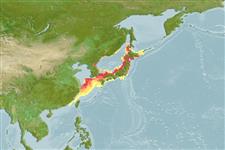Environment: milieu / climate zone / depth range / distribution range
Ökologie
seewasser demersal; tiefenbereich 15 - 269 m (Ref. 58496). Boreal
Northwest Pacific: Japan and the Sea of Okhotsk.
Size / Gewicht / Alter
Maturity: Lm ? range ? - ? cm
Max length : 44.0 cm TL Männchen/unbestimmt; (Ref. 56527); common length : 31.5 cm TL Männchen/unbestimmt; (Ref. 56557); max. veröff. Gewicht: 1.0 kg (Ref. 56527)
Rückenflossenstacheln (insgesamt) : 9 - 10; Rückenflossenweichstrahlen (insgesamt) : 14 - 17; Afterflossenstacheln: 0; Afterflossenweichstrahlen: 13 - 16.
Life cycle and mating behavior
Geschlechtsreife | Fortpflanzung | Ablaichen | Eier | Fecundity | Larven
External fertilization with internal insemination (Ref. 101419). This is also called 'internal gametic association' which describes another unique phenomenon of the reproductive process. In this phenomenon, the presence of the spermatozoa in the ovarian cavity is done through copulation, but the spermatozoa entry into the egg and subsequent fertilization only occurred externally when the eggs are spawned and came into contact with seawater (Ref. 101419).
Nakabo, T., 2002. Fishes of Japan with pictorial keys to the species, English edition I. Tokai University Press, Japan, pp v-866. (Ref. 41299)
IUCN Rote Liste Status (Ref. 130435: Version 2024-1)
Bedrohung für Menschen
Harmless
Nutzung durch Menschen
Tools
Zusatzinformationen
Download XML
Internet Quellen
Estimates based on models
Preferred temperature (Ref.
123201): 3.6 - 17.3, mean 12.9 °C (based on 37 cells).
Phylogenetic diversity index (Ref.
82804): PD
50 = 1.0000 [Uniqueness, from 0.5 = low to 2.0 = high].
Bayesian length-weight: a=0.00589 (0.00281 - 0.01234), b=3.15 (2.97 - 3.33), in cm total length, based on LWR estimates for this (Sub)family-body shape (Ref.
93245).
Trophic level (Ref.
69278): 3.6 ±0.4 se; based on diet studies.
Widerstandsfähigkeit (Ref.
120179): sehr niedrig, Verdopplung der Population dauert mehr als 14 Jahre. (Preliminary K or Fecundity.).
Fishing Vulnerability (Ref.
59153): Low to moderate vulnerability (34 of 100).
